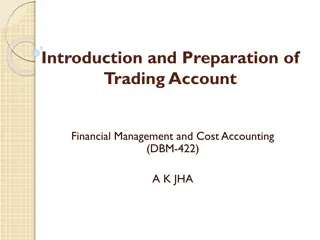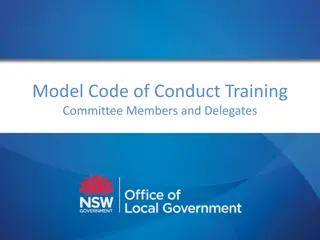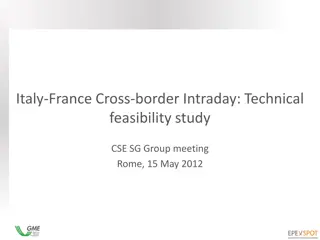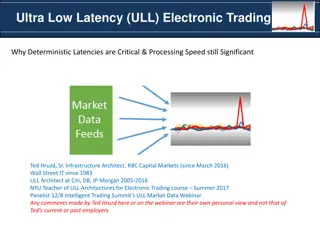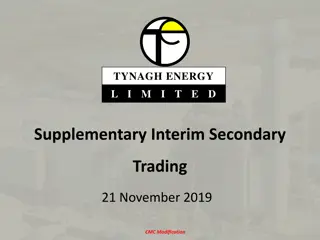Trading Conduct Review Briefing and Discussion Summary
The briefing on Trading Conduct Review, held by the Market Development Advisory Group in July 2019, discussed pivotal pricing and potential changes to trading conduct provisions. The project aims to evaluate and enhance trading conduct provisions to ensure fair competition. Key topics included understanding pivotal offers, current trading conduct provisions, and MDAG's preferred changes. The briefing emphasized the importance of stakeholder input and upcoming formal proposal submission processes.
Download Presentation

Please find below an Image/Link to download the presentation.
The content on the website is provided AS IS for your information and personal use only. It may not be sold, licensed, or shared on other websites without obtaining consent from the author.If you encounter any issues during the download, it is possible that the publisher has removed the file from their server.
You are allowed to download the files provided on this website for personal or commercial use, subject to the condition that they are used lawfully. All files are the property of their respective owners.
The content on the website is provided AS IS for your information and personal use only. It may not be sold, licensed, or shared on other websites without obtaining consent from the author.
E N D
Presentation Transcript
Trading conduct review: Briefing and Discussion Market Development Advisory Group 30 July 2019
Project description On 20 November 2017, the Authority wrote to the MDAG requesting that the MDAG include a review of spot market trading conduct provisions in its 2017/18 work plan. The project description is: Review of trading conduct provisions in light of events that have tested these provisions. Take into account any findings from case studies, performance reports and compliance reports. The project aim is: To ensure the trading conduct provisions are effective in promoting outcomes consistent with workable competition. 2
Purpose of briefing The briefing is an interim step in the MDAG s work on pivotal pricing, which is the initial focus of the MDAG s work on trading conduct. MDAG would like to update stakeholders on MDAG s thinking on how to change the Code in relation to pivotal offers. We d like to do this by a relatively informal briefing and discussion. It is important to note that MDAG has yet to complete its comparative evaluation of Code change options in relation to pivotal pricing. Also note that the normal consultation process has yet to come. Later this year, MDAG will issue a formal proposal paper setting out in full the analysis and rationale. That paper will invite formal submissions. In due course, this will be followed by a final recommendations report from MDAG to the Authority s Board. 3
Details The briefing will be held 2.30 4.30pm, 30 July 2019 (arrival from 2.15pm). We encourage you to come along to hear more about the project. Please RSVP to MDAG@ea.govt.nz if you are interested in attending. 4
Contents of this briefing pack Understanding pivotal Current trading conduct provisions what are they and where did they come from? MDAG s preferred change 5
Definition of pivotal Part 1 of the Code: pivotal means (a) in relation to a generator, that the total demand in a trading period at any 1 or more nodes would not have been met if the generator had not submitted offers for all or any of its generating plant; and (b) in relation to an ancillary service agent, that the total demand in a trading period for an ancillary service supplied by the ancillary service agent in an island would not have been met if the ancillary service agent had not submitted reserve offers for all or any of its capacity to provide instantaneous reserve in the island 7
Illustration of pivotal 30, 30, 20 MW all pivotal No generator is pivotal 15 404 20 15 404 20 15 40 40 404 30 404 30 40 40 404 30 404 30 Load Generation Load Generation Both generators are pivotal Only 60MW pivotal 15 15 404 35 15 40 40 404 60 404 60 40 40 Load Generation Load Generation 8
Definition of net pivotal From WAG discussion paper: A net pivotal supplier is a party that is required to generate to avoid unserved load and whose generation is greater than its own retail and hedge sales in the relevant area Reflected by clause 13.5B(1)(c)(iii) and 13.5B(3)(c)(iii) in safe harbours: 13.5B(1)(c)(iii) the generator does not benefit financially from an increase in the final price at which electricity is supplied in a trading period at a node at which the generator is pivotal 13.5B(3)(c)(iii) the ancillary service agent does not benefit financially from an increase in the final reserve price in a trading period in an island in which the ancillary service agent is pivotal 9
Net pivotal incentives When a supplier is net pivotal they have incentives to raise prices because: their hedge position, including retail, provides no financial constraint they lack competitive pressure, ie they have market power Accordingly, the trading conduct safe harbour provisions consider whether a generator or ancillary service agent is net pivotal: 13.5B(1)(c)(iii) the generator does not benefit financially from an increase in the final price at which electricity is supplied in a trading period at a node at which the generator is pivotal 13.5B(3)(c)(iii) the ancillary service agent does not benefit financially from an increase in the final reserve price in a trading period in an island in which the ancillary service agent is pivotal 10
Fully hedged pivotal incentives A supplier that is pivotal but not net pivotal, ie with generation hedges/retail, may still have incentives to raise prices in the short term: it may allow the supplier to supply hedges at a higher premium in the future it may undermine more exposed competitors and potentially force them to leave the market Accordingly, a party that is pivotal could potentially be in the trading conduct safe harbour because they do not benefit financially from high prices in the short term, even though they might in the long term 11
Generators are often pivotal Modelled by setting prices to $30k for plant in region shown (eg Contact, South Island means setting Contact s SI plant to $30k) Graphs show percentage of time the supplier s generation in that region (ie North Island, South Island, across New Zealand) is required to meet national demand Note the Code considers whether a party is pivotal on a nodal basis Contact, South Island Contact, North Island Contact, New Zealand Meridian, South Island Genesis, North Island Mercury, North Island 12
Current trading conduct provisions 14
The trading conduct provisions in the Code are as follows: 15
Overview of trading conduct provisions 13.5 Bids and offers must be lawful (i) Pivotal generator s offer results in material increase in price c.f. previous period or when not pivotal? Consistent with a HSOTC No 13.5A Generators and ancillary agents offers consistent with a HSOTC? Consistent with a HSOTC No No No Yes 13.5B Safe harbour A generator complies with 13.5 A if: 1(b) Timely offer updates 1(c) Pivotal at node(s) 1(a) Offers all capacity Yes Yes Yes (ii) Offer consistent with offers when not pivotal? Consistent with a HSOTC Yes No (iii) Generator does not benefit financially from increase in price? Trader outside the safe harbour Consistent with a HSOTC No Yes Diagram adapted from Sapere presentation to MDAG, 15 March 2018 18
UTS provisions The relationship between the Code s provisions on high standard of trading conduct and undesirable trading situations is unclear 19
Origin of HSTC provisions In 2012, the Authority asked WAG to consider issues relating to pivotal supplier situations. WAG did not identify any specific efficiency losses arising from local or wider pivotal situations; however, WAG s analysis indicated potential for material efficiency loses to arise in some scenarios . Given the uncertainty as to the extent of potential efficiency losses, WAG advised that any change should: have a relatively low risk of unintended consequence, be flexible, and be relatively easy to reverse. WAG recommended a high standard of trading conduct provision ( HSTC ) for generators and ancillary agents with a pivotal position at an island wide or national level. The Authority decided that the HSTC provision should apply to all parties making offers. 21
Origin of HSTC provisions (contd) As the Authority states in its 2017 Meridian decision: the high standard of trading conduct provisions were introduced to improve the efficiency of prices in pivotal supplier situations . However, instead of promulgating a set of provisions targeted at pivotal supplier situation, WAG and the Authority opted for an unusual combination of: A motherhood and apple pie standard with broad application high standard of conduct which is poorly defined at law and uncertain in its scope and practical effect in this market; and A specific carve-out (safe-harbour) relating to a narrow aspect of but one dimension trading behaviour. WAG seems to have assumed that this option satisfies its three criteria (previous slide). However, WAG does not seem to have undertaken any detailed analysis of its likely scope or effect, in law or practice. 22
Origin of HSTC provisions (contd) It was intended that the scope, meaning and application of this HTSC mechanism would become better defined over time as it is applied to specific cases and a body of enforcement decisions evolves. In other words, the boundaries and effect of what is a very broadly worded standard (HSTC) are to be determined by a process of incremental interpretation and application by the Authority, the Rulings Panel and (ultimately) the courts. Since the HSTC provisions were promulgated, there have been two compliance investigations, both of which related to alleged misuse of a pivotal position. 23
Key elements This option involves: deleting the existing trading conduct provisions in the Code (clauses 13.5A and 13.5B, at least in so far as these provisions apply to offers made by pivotal suppliers) retaining the existing definition of pivotal in Part 1 of the Code introducing new provisions to the Code applying specifically to suppliers in a pivotal position. These provisions would require pivotal suppliers to make offers consistent with offers they would make under workable competition. 25
Indicative new provisions The new provisions would reflect the following: a) offers are consistent with offers they would make when they are subject to workable competition In making offers, generators and ancillary service agents must ensure that their b) agents, or the Authority, as appropriate, must consider whether the offer would promote efficient: In assessing whether offers comply with (a), generators and ancillary service locational signals for suppliers (generators and other providers of electricity services) and consumers consumption decisions by consumers investment by both suppliers and consumers risk management and risk management markets c) would reflect workable competition The assessment under (b) must demonstrate how the impact under (b)(i) (iv) d) in which the generator is located and regions supplied by the generator. For generators, the assessment under (b) must be with respect to both the region 26
Advantages Relative to the status quo, the advantages of this option are that it: more directly targets the problem identified in relation to behaviour by pivotal suppliers, namely that offers by such parties may result in prices and therefore outcomes that do not promote efficiency aligns the relevant test in the Code with the framework and the criteria used by the Authority in relation to pivotal issues focuses on offers, which are within suppliers control, rather than prices, which may be the result of factors outside suppliers control is applicable to suppliers in any pivotal situation, be it temporary or permanent, local, regional or national doesn t rely on the legally nebulous concept of a high standard of trading conduct (HSOTC) reduces the risk of the Courts introducing considerations into the evaluation (under the rubric of a HSOTC) that are extraneous to the way in which the Authority would evaluate pivotal events avoids unintended incentives and outcomes from the technical safe harbour definitions under the current clause 13.5B of the Code. 27
Other considerations Other considerations in relation to this option are: it is based on economic concepts, so would require parties that may be subject to the requirements to become familiar with those concepts and reflect them in offer decisions like the status quo, it is likely to require development of a pattern of enforcement decisions, and possibly guidelines, in order to be fully effective over time it utilises terms, eg workable competition, that have established legal meanings in relevant contexts (see next slides) it focuses only on pivotal and does not seek to address other behaviours that may leads to inefficient outcomes in the market, which are better addressed by other mechanisms to be introduced into the Code it only applies to parties making offers, so may not capture all parties that may be pivotal (however, this could be potentially addressed by expanding its application to supply decisions by all parties supplying the electricity market that are pivotal). 28
1. Leading judicial authorities on concept of workable competition NZME LIMITED v COMMERCE COMMISSION [2018] NZCA 389 [26 September 2018] [NZ Court of Appeal] - http://img.scoop.co.nz/media/pdfs/1809/2018NZCA389_NZMEvComCom.pdf At para [34]: The concept of workable or effective competition is traced, via Re Queensland Co- operative Milling Association Ltd (QCMA),27 to the 1955 Report of the United States Attorney-General s National Committee to Study the Antitrust Laws:28 The basic characteristic of effective competition in the economic sense is that no one seller, and no group of sellers acting in concert, has the power to choose its level of profits by giving less and charging more. Where there is workable competition, rival sellers, whether existing competitors or new or potential entrants into the field, would keep this power in check by offering or threatening to offer effective inducements Footnote 28: Stanley N Barnes and S Chesterfield Oppenheim Report of the United States Attorney-General s National Committee to Study the Antitrust Laws (United States Department of Justice, March 1955) at 320. The concept is further traceable to the work of the Harvard economist Edward S Mason: see the discussion in Alan J Meese Debunking the Purchaser Welfare Account of Section 2 of the Sherman Act: How Harvard Brought Us a Total Welfare Standard and Why We Should Keep It (2010) 85 NYU L Rev 659 at 692 693. 29
2. Leading judicial authorities on efficiency GODFREY HIRST NZ LIMITED V COMMERCE COMMISSION [2016] NZCA 560 [30 November 2016] [NZ Court of Appeal] - https://comcom.govt.nz/__data/assets/pdf_file/0036/69399/Godfrey-Hirst-NZ-Ltd-v-Commerce-Commission-Court-of-Appeal- Judgment-30-November-2016.PDF At para [13], the Court of Appeal also cited with approval its 1988 decision in Tru Tone Limited v Festival Records Marketing Limited*, which held that: [the Commerce Act] is based on the premise that society s resources are best allocated in a competitive market where rivalry between firms ensures maximum efficiency in the use of resources . Footnote *: [1988] 2 NZLR 352 at 358 At para [16], the Court of Appeal further noted its earlier decision in Tru Tone Ltd: [The Court of Appeal] does not view the promotion of competition as an end in itself but, rather, as a vehicle for fostering overall economic efficiency. 30
2. Leading judicial authorities on efficiency(contd) At para [19], the Court of Appeal cited with approval the High Court s decision in AMPS-A HC26, which among other things held that efficiency has three dimensions: We bear in mind that efficiency has three dimensions commonly referred to as allocative efficiency, production efficiency and dynamic efficiency . Footnote 26: Telecom Corporation of New Zealand Ltd v Commerce Commission (1991) 4 TCLR 473 (HC) [AMPS-A HC] At para [20], the Court of Appeal also noted that: Efficiency became an established pillar of New Zealand s competition law and policy . This definition of efficiency was established in the context of the Commerce Act, however the relevant language is closely analogous to the use and context of efficiency in the Electricity Authority s statutory purpose. 31
3. Electricity Authority s objective in relation to pivotal pricing The Authority s stated objective in relation to pivotal pricing is to improve the efficiency of prices : Authority on 2 June 2016: Meridian used its pivotal position to cover its unhedged risk.., which essentially resulted in the cost of the risk being met by other parties. The high standard of trading conduct provisions were introduced to improve the efficiency of prices in pivotal supplier situationsand the Board would have expected Meridian to have adopted more responsible trading behaviour, either by covering its risk using other available risk management products or bearing the cost of the risk if it eventuates Note: Other useful judicial citations in relation to economic efficiency http://www.nzlii.org/cgi- bin/LawCite?cit=%5b1992%5d%203%20NZLR%20429?query=%22economic%20efficiency%22 32







![Guardians of Collection Enhancing Your Trading Card Experience with the Explorer Sleeve Bundle [4-pack]](/thumb/3698/guardians-of-collection-enhancing-your-trading-card-experience-with-the-explorer-sleeve-bundle-4-pack.jpg)








